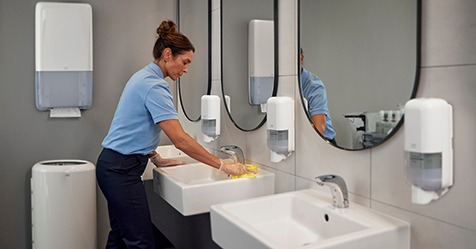Could Smart Restrooms Jeopardize Your Privacy?
Experts weigh in on whether too much restroom data could be intrusive
Today’s smart restrooms go beyond automatic paper towel dispensers and self-flushing toilets.
Internet of Things (IoT) technology can count the number of restroom visitors and alert custodians when to clean toilets and replace paper products. Smart toilets can check users’ vitals.
The European Cleaning Journal takes a comprehensive look at some of the latest restroom technology and its implications on privacy.
For example, a Japanese company is currently developing a toilet that uses artificial intelligence to analyze human waste. Sensors in the seat of the Wellness Toilet record the user’s pulse and blood pressure while analyzing their waste via technology embedded in the bowl. Meanwhile, the Rochester Institute of Technology in Henrietta, New York, has pioneered a cloud-connected toilet that can track the user’s blood pressure, blood oxygen levels, and other heart data.
More controversially, some public restrooms in China use facial recognition technology to limit people’s’ use of toilet paper. Restroom visitors’ faces are scanned before they are allowed access to paper, then they are restricted from taking any more for a seven-minute period. The use of these facial recognition toilet paper dispensers was paused in some parts of China late last year amid fears that the data could be stored and used for other purposes.
Similarly, in 2019, concerns were raised about a toilet developed at the University of Wisconsin-Madison. The smart toilet contained sensors for assessing the user’s sleep patterns and exercise habits as well as their medication, alcohol, and caffeine intake. But there were fears that hackers could access this sensitive information on route to the user’s physician.
Hygiene and technology experts are debating whether there should be limits on the type and scope of information toilets and other restrooms fixtures gather. Renée Remijnse, a communications director with Essity Professional Hygiene believes the use of restroom data and connectivity from IoT technology is essential as it can result in increased restroom efficiency and cleanliness. However, she feels that facial recognition systems for limiting paper use are unnecessary because consumption reduction can be achieved much more simply through a single-sheet dispensing system.
Remijnse sees some value in smart toilets that can perform health analysis if the companies that develop these technologies value users’ privacy.
Diversey’s retail and distribution European marketing director Angelika Koppe is unconvinced about the usefulness of toilets that can monitor the user’s health or dispensers that use facial recognition technology to limit toilet paper use. “In my personal view, this is an invasion of privacy,” she said.
However, Diversey sees no problem with technology that tracks the number of restroom visitors and is currently considering the introduction of restroom monitoring systems that indicate when toilets need to be cleaned and dispensers need to be refilled. “I think this is the future,” Koppe said.


